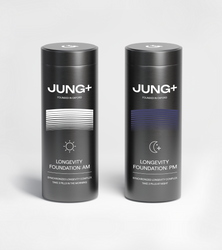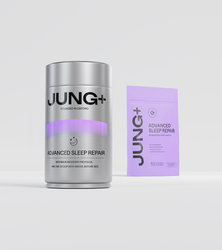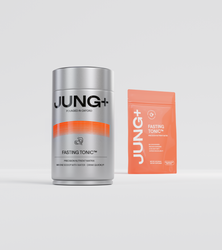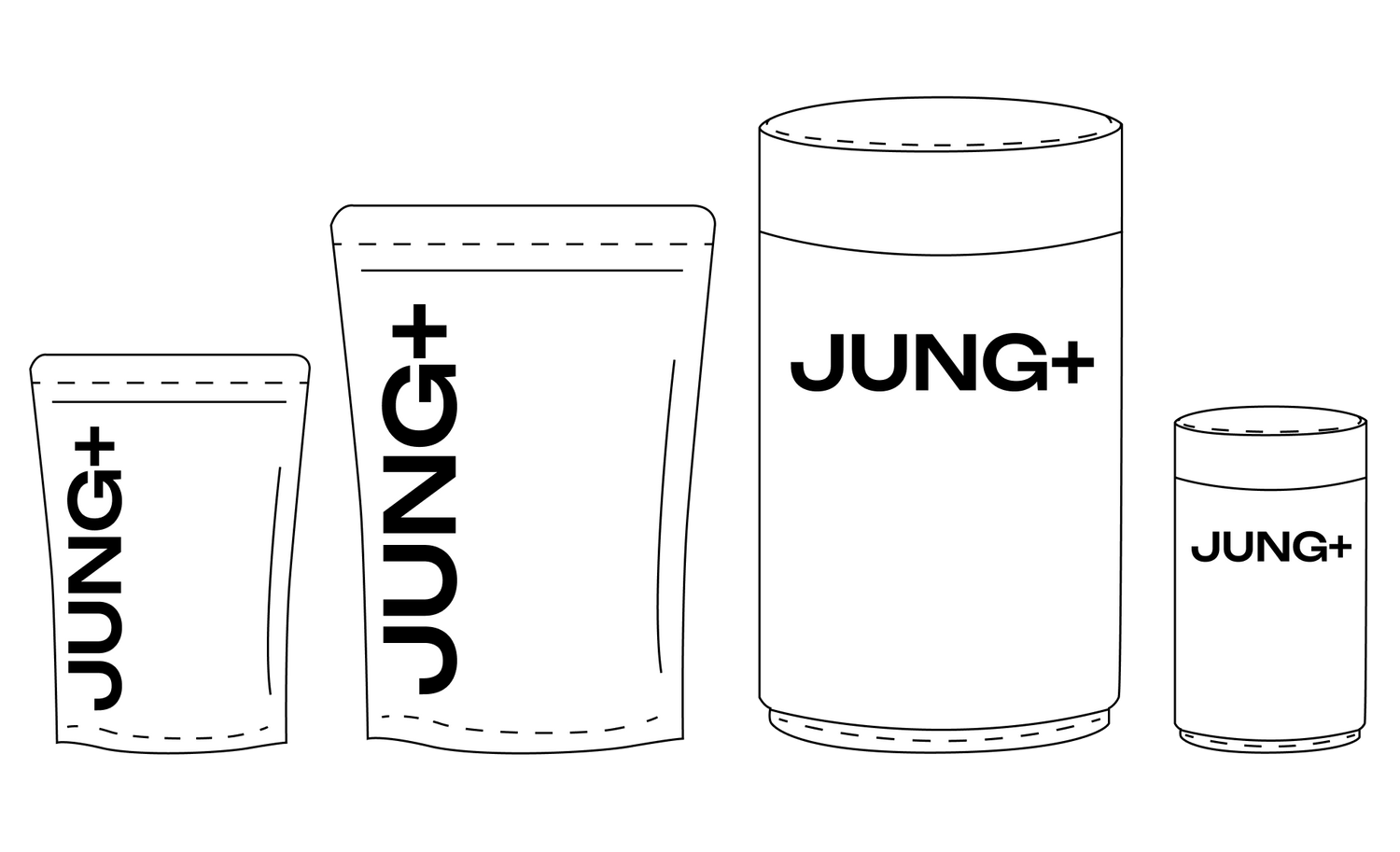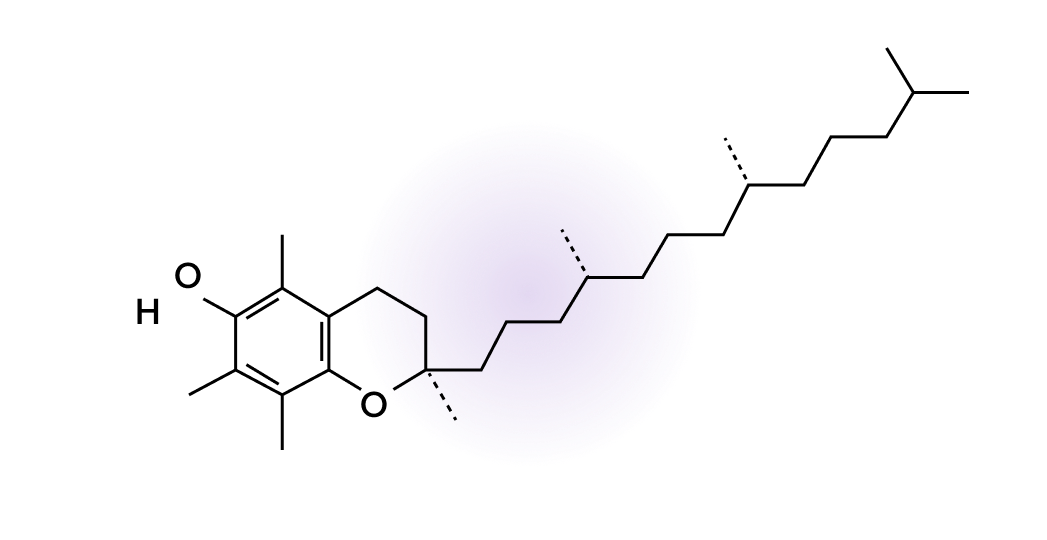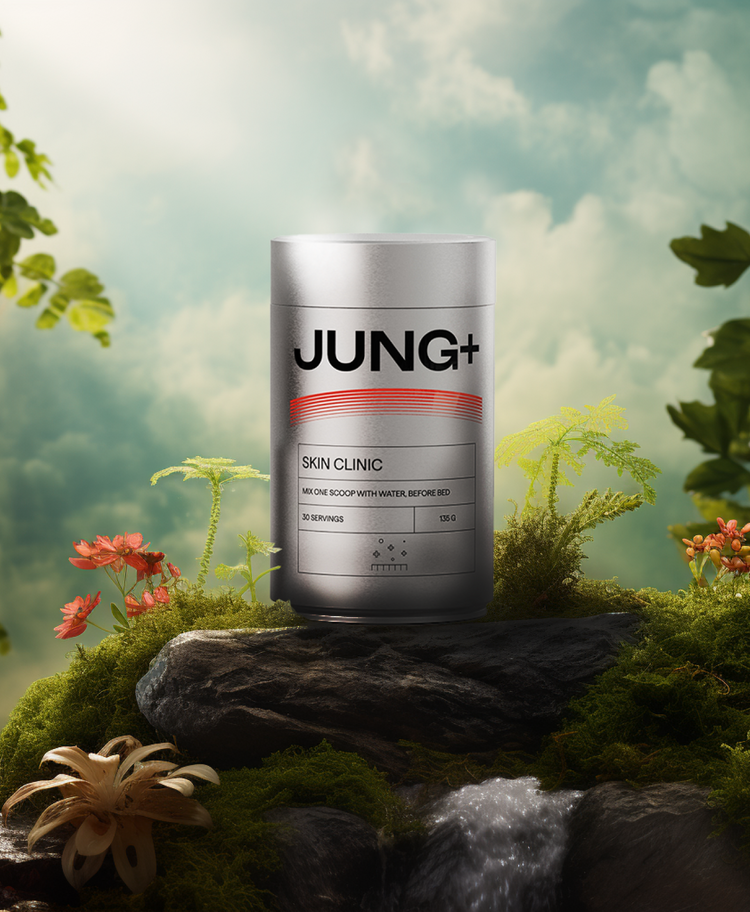Longevity Foundation 2024
Welcome to the future of anti-aging. Devised by world-leading longevity experts, our foundational formula works around the clock to tackle aging at its roots, addressing all 12 known drivers of aging with precision. Our pioneering time-released AM/PM system, tailored to your body's natural rhythms, enables precision targeting, like having the guidance of a longevity clinician, 24/7. Formulated to modulate crucial longevity mechanisms like AMPK, mTOR, sirtuins signaling pathways, NAD+ levels, mitochondrial health, and cellular renewal, the combination helps support younger skin, a sharper mind, and a stronger body. With Longevity Foundation, you're challenging the very core of aging biology, with ingredients backed by 100+ studies.
Couldn't load pickup availability
As seen in
Two powerful formulas, one complete longevity regimen
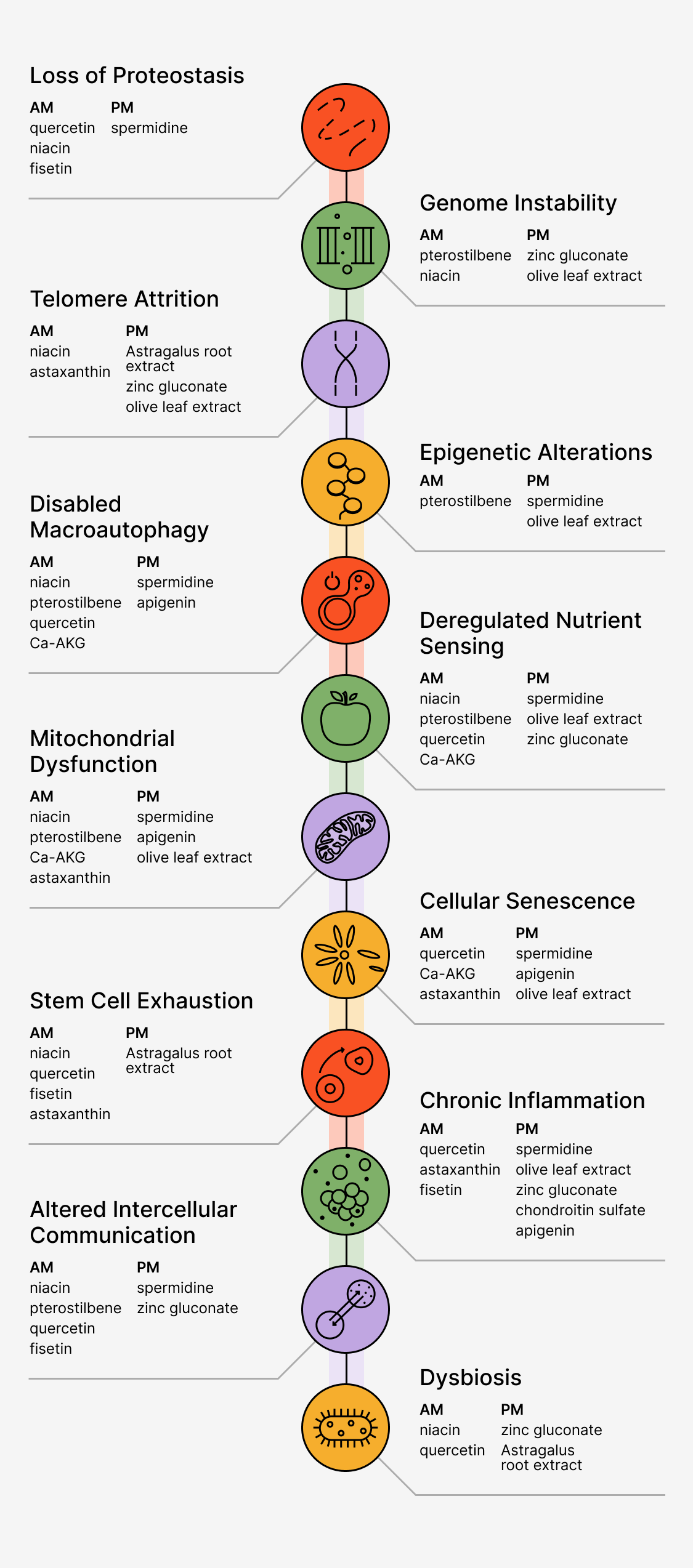

Collapsible content
Discover the unique benefits that set us apart.
Targets 12 Drivers Of Aging With AM/PM Precision
24/7 Defense, for Optimal Bioavailability and Alignment
Targets 12 Drivers Of Aging With AM/PM Precision
24/7 Defense, for Optimal Bioavailability and Alignment
Younger Skin From Within
Foundational Dermal Longevity
Younger Skin From Within
Foundational Dermal Longevity
Multi-Factor Cellular Clean-up
Clear Aging Cells and Revitalize Your Body From Within.
Multi-Factor Cellular Clean-up
Clear Aging Cells and Revitalize Your Body From Within.
Protect and Preserve Brain Health
For Peak Cognition, Today and Tomorrow.
Protect and Preserve Brain Health
For Peak Cognition, Today and Tomorrow.
Synergistically Boost NAD+
3-Part Strategy to Support NAD+ Levels
Synergistically Boost NAD+
3-Part Strategy to Support NAD+ Levels
Strengthen Muscles, Nourish Joints
Keep Moving, Stay Youthful
Strengthen Muscles, Nourish Joints
Keep Moving, Stay Youthful
All-Day Energy, Strength & Vitality
Fuel Mitochondria, Enhance Muscle Strength, and Nourish Joints.
All-Day Energy, Strength & Vitality
Fuel Mitochondria, Enhance Muscle Strength, and Nourish Joints.
Protect Cells From Damage
Shield Cells from Oxidative Stress
Protect Cells From Damage
Shield Cells from Oxidative Stress
Fight Inflammaging, Boost Immunity
Target Inflammation to Age Healthier and Live Stronger.
Fight Inflammaging, Boost Immunity
Target Inflammation to Age Healthier and Live Stronger.
Protect Your Telomeres
Slow Cellular Aging
Protect Your Telomeres
Slow Cellular Aging
Improved Gut Microbiome
Nourish Your Gut, Elevate Your Health
Improved Gut Microbiome
Nourish Your Gut, Elevate Your Health
How to use
Collapsible content
AM - Niacin (NAD+ Booster)
200 mg
AM - Niacin (NAD+ Booster)
200 mg
AM - Pterostilbene
100 mg
AM - Pterostilbene
100 mg
AM - Quercetin
200 mg
AM - Quercetin
200 mg
AM - Calcium Alpha-Ketoglutarate
1,000 mg
AM - Calcium Alpha-Ketoglutarate
1,000 mg
AM - Fisetin
50 mg
AM - Fisetin
50 mg
AM - Astaxanthin
3.5 mg
AM - Astaxanthin
3.5 mg
PM - Spermidine
2.5 mg
PM - Spermidine
2.5 mg
PM - Zinc
10 mg
PM - Zinc
10 mg
PM - Oleuropein (Olive Leaf Extract)
650 mg
PM - Oleuropein (Olive Leaf Extract)
650 mg
PM - Astragalus
100 mg
PM - Astragalus
100 mg
PM - Chondroitin
700 mg
PM - Chondroitin
700 mg
PM - Apigenin
50 mg
PM - Apigenin
50 mg
What are the 12 hallmarks of aging, how can they be addressed?
Learn more
Age is the single largest risk factor for an enormous number of diseases. So, if you can essentially postpone aging, then you can have beneficial effects on a whole wide range of disease.
Dr. Cynthia Kenyon, molecular biologist and pioneer in aging research
Founded in Oxford - we’ve done our homework
At Jung+, we're on a crusade to liberate human longevity, translating the latest scientific advancements in aging research into products and technologies that can slow aging and extend healthy lifespan
Our scientistsGMP certified
Manufactured in facilities that follow Good Manufacturing Practices (GMP), ensuring the highest quality and purity.
Scientist Approved
Formulated by experts and rigorously evaluated by scientists to ensure effectiveness and safety.
Clinical-Grade Dosage
Contains the precise dosages used in clinical studies, ensuring you receive the optimal amount for maximum benefit.
Made in the USA
Proudly produced in the USA, ensuring adherence to the highest standards of quality and safety.
Real results from real people
Meet our JUNG+ community
FAQ’s
-
Can I use it as a replacement for my multivitamin supplement?
-
When will I see the first effects?
-
I'm feeling lazy. Can I take both AM + PM pills at once?
-
I forgot yesterday's dose. Should I take double the dose the next day?
-
Is this supplement all I need to live a longer, healthy life?
-
I'm pregnant! Can I continue taking the supplement?
-
I heard resveratrol is great for slowing aging - why didn't you include this?
-
I hear NMN is great for aging - why didn't you include this?
-
Why are the doses divided into morning and evening formulas?
-
I've heard of other longevity compounds. Why did you put them in other Jung+ formulas and not this?
Scientific studies
-
Niacin is a precursor for the coenzyme NAD+.
-
Fisetin is a senotherapeutic that might extend health and lifespan
-
Pterostilbene has become an attractive drug candidate for treating several disease conditions.
-
Induction of autophagy by spermidine promotes longevity
-
Quercetin causes apoptosis in the A-549 lung cancer cell lines.
-
Higher spermidine intake is linked to lower mortality
-
Alpha-ketoglutarate may extend human healthspan.
-
Astaxanthin can modulate Nrf2, FOXO3, Sirt1, and Klotho proteins linked to longevity.
-
Supplementation with olive leaf extract ameliorates age-related vascular and metabolic changes in Wistar rats.
-
The extract component of Astragalus membranaceus can increase telomerase activity.
-
Zinc is essential for immune efficiency, metabolic homeostasis, and antioxidant activity.
-
Chondroitin sulfate can potentially become a geroprotective strategy to promote health during human aging.
-
Oleuropein, unexpected benefits!
-
Polyphenols like oleuropein are the therapeutic agents of olive oil
-
Inhibitory effect of astaxanthin on oxidative stress-induced mitochondrial dysfunction-a mini-review
-
Astaxanthin: A potential mitochondrial-targeted antioxidant treatment in diseases and with aging
-
Pterostilbene: Sources, Metabolism, Health Promotion Effects, And Superiority to Resveratrol
-
Chondroitin Sulfate as a Potential Longevity Pill
-
Apigenin and NAD+
All References
-
da Silva AC, Paiva JP, Diniz RR, Dos Anjos VM, Silva ABS, Pinto AV, et al. Photoprotection assessment of olive (Olea europaea L.) leaves extract standardized to oleuropein: In vitro and in silico approach for improved sunscreens. Journal of Photochemistry and Photobiology B: Biology. 2019;193:162-71.
-
Van Dronkelaar C, van Velzen A, Abdelrazek M, van der Steen A, Weijs PJ, Tieland M. Minerals and sarcopenia; the role of calcium, iron, magnesium, phosphorus, potassium, selenium, sodium, and zinc on muscle mass, muscle strength, and physical performance in older adults: a systematic review. Journal of the American Medical Directors Association. 2018;19(1):6-11. e3.
-
Demidenko O, Barardo D, Budovskii V, Finnemore R, Palmer FR, Kennedy BK, et al. Rejuvant®, a potential life-extending compound formulation with alpha-ketoglutarate and vitamins, conferred an average 8 year reduction in biological aging, after an average of 7 months of use, in the TruAge DNA methylation test. Aging (Albany NY). 2021;13(22):24485-99.


